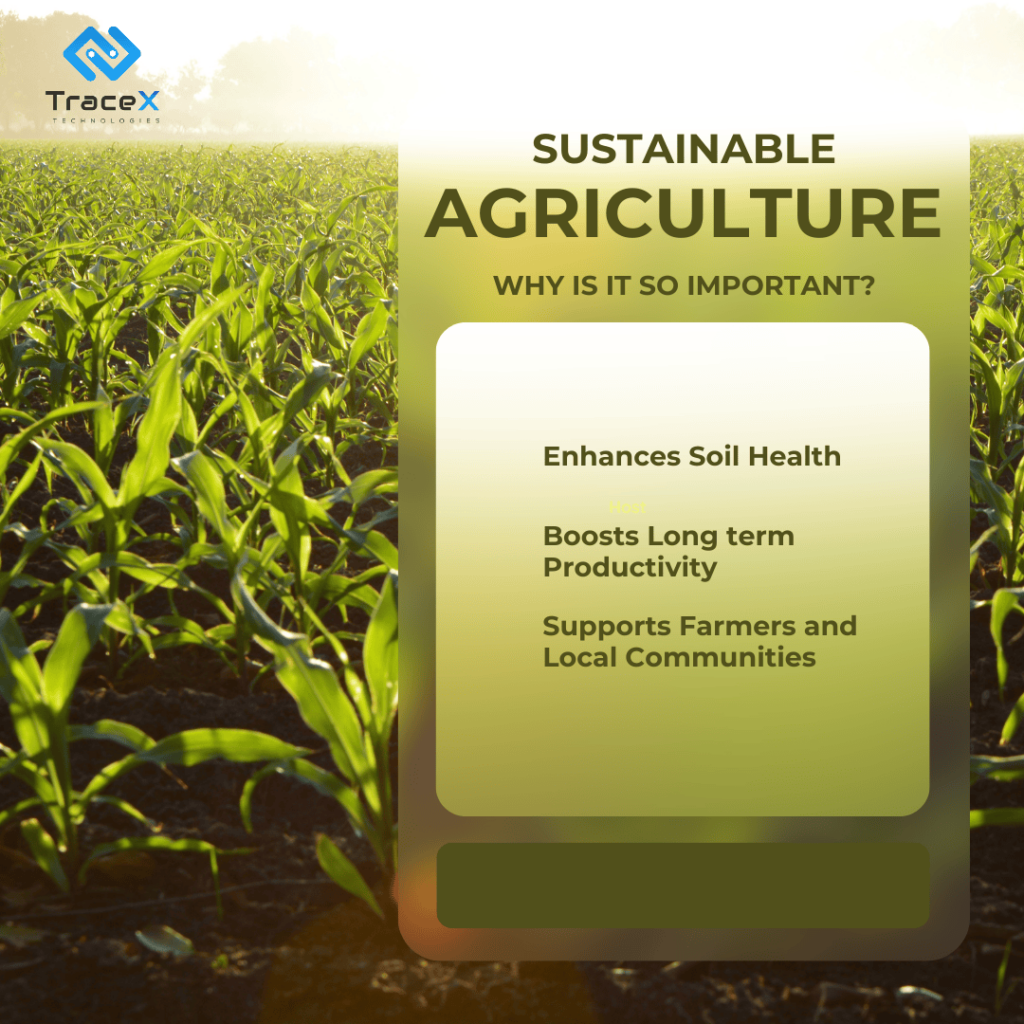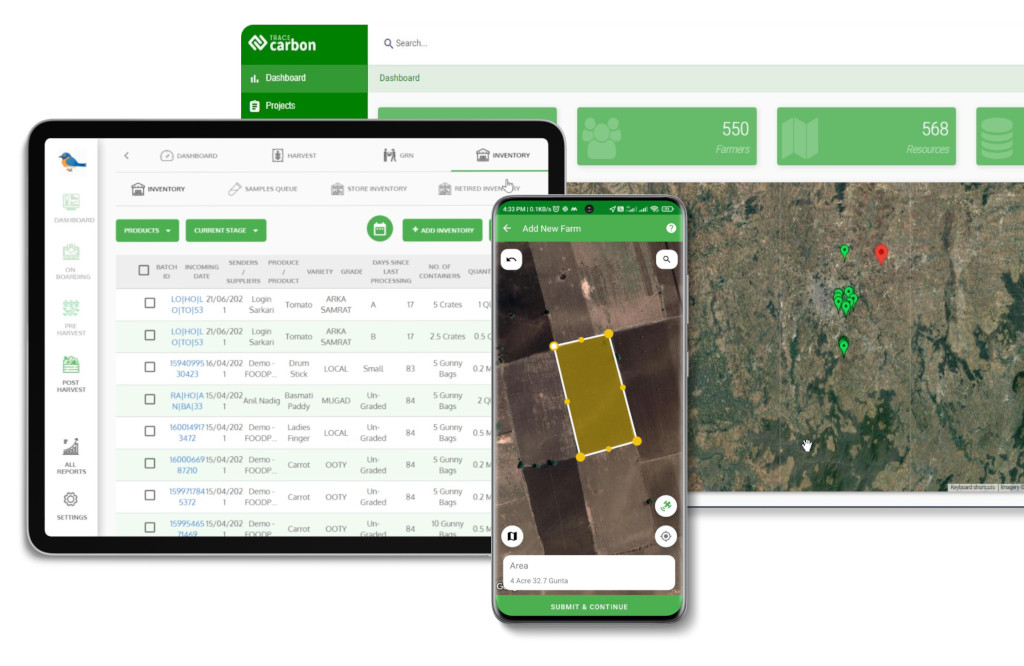Contact: +91 99725 24322 |
Menu
Menu
Quick summary: Discover the top 7 best practices in sustainable agriculture that are revolutionizing the farming industry. From regenerative farming techniques to innovative water management strategies, this blog highlights actionable steps for a greener future. Learn how sustainable agriculture can lead to improved yields, environmental conservation, and a resilient food system. Read on to unlock the secrets of sustainable farming practices and contribute to a more sustainable world.

Can you prove your farming methods are truly sustainable?” In today’s global food economy, simply claiming sustainability isn’t enough. Whether you’re a cooperative manager, an agribusiness leader, or a progressive farmer, you’re under mounting pressure to show real, verifiable practices that protect the environment, enhance soil health, and build long-term productivity. This is where understanding and implementing sustainable agriculture practices becomes not just an ethical choice — but a strategic, competitive necessity.
According to FAO, sustainable agriculture practices have the potential to increase global crop yields by up to 20% while simultaneously reducing greenhouse gas emissions and conserving water resources.
In this article, we’ll explore the 7 best sustainable agriculture practices that leading agribusinesses and farmers are adopting to not only meet global standards but to future-proof their businesses in a fast-changing world.
Key Takeaways
Sustainable agriculture practices are all about farming in a way that’s good for the planet, people, and profits. They involve methods that conserve resources, protect ecosystems, and support the well-being of farm communities. But why do these practices matter so much?

Sustainable farm management and agriculture practices are pivotal in supporting low carbon agriculture supply chains. By focusing on efficient resource use, enhancing soil health, and reducing emissions from inputs, these practices help lower the carbon footprint of farming operations. Sustainable management methods, such as optimizing energy use and promoting resilience through diversified crop systems, further contribute to this goal. Additionally, by improving transparency and traceability in the supply chain, sustainable practices ensure more accurate carbon footprint reporting. Together, these approaches create a more resilient, efficient, and environmentally friendly agricultural system, driving significant reductions in carbon emissions and fostering a sustainable future.
In short, sustainable agriculture is about making choices today that ensure we have thriving farms and a healthy planet for tomorrow. It’s a win-win for everyone involved.
The “7 Practices” framework covers important facets of sustainable farming. It covers techniques like integrated pest management (IPM), nutrient management, waste management, energy efficiency, and biodiversity conservation. These strategies seek to advance sustainable agricultural practices, safeguard natural resources, lessen negative environmental effects, and increase the productivity and resilience of agricultural systems. Farmers may contribute to a more sustainable and accountable agriculture sector by putting these practices into practice.

Conservation tillage is a farming technique that reduces or eliminates conventional tillage activities to reduce soil disturbance and erosion. It includes methods like no-till or reduced tillage, where farmers hardly disturb the soil and leave crop residue on top. Conservation tillage contributes to better soil health, moisture retention, erosion prevention, and carbon dioxide emissions reduction.
Crops are planted without causing soil disturbance, preserving soil structure, and minimizing erosion in no-till farming Strip-tilling conserves soil while facilitating nutrient placement because it disturbs only a small area where seeds are planted. By adding organic materials to the soil surface, mulching can improve water retention and nutrient cycling while lowering evaporation. These methods encourage the use of sustainable farming methods while conserving soil and improving water efficiency.
Advantages
Significant advantages are provided by decreased soil erosion and enhanced soil health. Farmers can stop the loss of fertile topsoil, maintain soil structure, and keep soil that is nutrient-rich by controlling soil erosion. As a result, there is an increase in crop yield, better water infiltration, and less silt buildup in water bodies. Additionally, better soil health fosters biodiversity, encourages advantageous microbial activity, and makes agricultural systems more resistant to adverse weather occurrences.
Changing the crops that are cultivated in a field over time is an agricultural practise known as crop rotation. It contributes to increased agricultural output by managing pests and diseases, enhancing nutrient availability, and improving soil health. Crop rotation allows farmers to disrupt the cycles of pests and diseases, lessen soil erosion, and advance resilient and sustainable agricultural practises.
Advantages
Crop rotation has a number of benefits for controlling diseases and pests. Farmers can limit pest and disease buildup in the soil, stop the spread of diseases, and lessen pest load on certain crops by rotating their crops. This method adds to resilient farming systems, increases overall plant health, and lessens dependency on chemical pesticides.
Examples of crop rotation systems:
Agroforestry is a method of land management that combines trees or shrubs with livestock or agricultural products. It increases sustainability and ecological services by fusing the benefits of trees and agricultural output. For increased production and better environmental results, agroforestry practices include the variety of plant species, preservation of biodiversity, sustainable land use, and promotion of ecological resilience.
Benefits of integrating trees with crops or livestock:
Alley cropping (the blending of trees and crops) and silvopasture (the blending of trees and livestock) are two examples of agroforestry techniques. These methods improve soil health, lessen erosion, increase biodiversity, and sequester carbon, among other advantages that support environmental sustainability.
By combining cultural, biological, and chemical control strategies, integrated pest management (IPM), a form of pest management, aims to reduce the usage of synthetic pesticides. Its goals are to efficiently control pest populations, lessen the dangers and harm caused by pests, and promote ecologically friendly and sustainable pest management techniques.
IPM uses cultural techniques including crop rotation and intercropping to interrupt pest life cycles, manage pest populations, and use fewer pesticides in sustainable agriculture. Biological control, which employs natural enemies to fight pests, is also a component of IPM.
IPM practices that use fewer pesticides protect non-target creatures, maintain ecosystem health, and lessen environmental contamination. IPM increases natural pest management by promoting beneficial insects, which lowers pest populations and the need for chemical pesticides.
A fertile, nutrient-rich environment for plant growth, improved water infiltration and retention, and the maintenance of beneficial soil organisms all depend on healthy soil, which is crucial for sustainable agriculture. It is a cornerstone of sustainable farming methods since it increases crop output, decreases the demand for synthetic inputs, and mitigates climate change through carbon sequestration.
Composting, organic amendments, and cover crops are crucial techniques in sustainable agriculture. The use of cover crops enhances soil structure, controls weed growth, and boosts organic matter. Composting increases microbial activity, improves soil fertility, and adds nutrients. The sustainability of agricultural systems, nutrient cycling, and long-term soil health are all benefited by organic amendments.
Increased water retention promotes water resource conservation and irrigation effectiveness, while increased soil fertility increases agricultural productivity and nutrient availability. By storing carbon dioxide, reducing greenhouse gas emissions, and improving overall environmental sustainability, carbon sequestration in soil aids in the fight against climate change.
Optimising crop output, maintaining water availability for future generations, reducing the danger of water shortages, and promoting sustainable use of water resources are all dependent on effective water management in agriculture. These factors all contribute to global food security and environmental sustainability.
Dribble irrigation, precise watering, and water recycling are agricultural practises that ensure targeted and sustainable irrigation practises for increased crop productivity and water conservation. These practises also encourage efficient water use, reduce water loss due to evaporation and runoff, and conserve water resources.
Reducing the possibility of water scarcity while ensuring long-term availability for agriculture and ecosystem health are all benefits of water resource conservation. Water quality is protected, aquatic ecosystems are maintained, and environmental and human well-being are sustained by reducing water pollution.
The diversity of living things in a particular ecosystem is referred to as biodiversity. The promotion of ecosystem resilience, pollination, natural pest management, soil fertility, and all-around sustainable farming practices depend critically on biodiversity in the agricultural sector.
Conservation of biodiversity is aided by actions like maintaining hedgerows, wildflower strips, and wildlife habitats in agricultural environments. Hedgerows offer helpful insects and birds a home, food, and places to nest. While natural habitats provide safe havens for many species, enhancing ecological balance and encouraging sustainable farming, wildflower strips draw pollinators and beneficial insects.
Bee and butterfly conservation increase crop pollination, which boosts crop yields and quality in agricultural production. Encouragement of beneficial insects for natural pest management lessens the need for chemical pesticides and aids in keeping pest populations under control. These methods help to ensure the long-term sustainability and productivity of agricultural systems by promoting ecosystem resilience, which promotes a healthy and balanced environment for both crops and wildlife.
Implementing and tracking sustainable agriculture practices can be challenging, and it’s not always as straightforward as it seems.
What’s the Easiest Way to Show My Farming is Sustainable — Digitally
It’s not about trying to do everything manually or chasing certifications after the season ends.
That’s the old way — and it’s too slow, too messy, and too risky for today’s global markets.
The easiest way to show your farming is sustainable digitally is this
In real terms, this means:
Good digital tools don’t create extra work — they make your real work visible, credible, and valuable.
And the real beauty?
Once your practices are digitized, you’re not just checking boxes for compliance.
You’re opening doors to premium markets, better prices, and trusted partnerships — the kind that grow your business, not just survive another season.
Sustainable farming isn’t just about adopting better practices — it’s about proving them.
Today’s buyers, certifiers, and regulators demand more than promises. They want real evidence:
This is exactly where TraceX Sustainability Platform bridges the gap between good intentions and real, trusted proof.

TraceX empowers farmers and cooperatives to digitally record every on-farm activity — from sowing dates to weeding schedules, irrigation events to organic pesticide applications — using a simple mobile app, even offline.
When it’s time to show how your crops were managed sustainably, you’ll have a clear, timestamped activity history — no guesswork, no missing data.
See how TraceX’s Custom Activities and Surveys can help you standardize data collection, accelerate audits, and prove your impact with confidence — just like our leading agribusiness partners.
Read the story and Start Building Verifiable, Trustworthy Supply Chains Today.

Managing sustainability means managing inputs smartly.
TraceX lets farmers track every seed, fertilizer bag, and chemical application, linking it back to individual fields and crops.
You’ll know exactly what was used, when, where, and how much — essential for Organic certification, ESG reporting, and soil conservation audits.
Show buyers and certifiers that your crops aren’t just “claimed organic” — they are proven compliant with real input histories.
See how TraceX’s Input Management & Inventory Tracking Solution helps leading food manufacturers achieve real-time visibility, smarter procurement, and error-free input distribution across thousands of farmers.
Book a Free Demo and Start Digitizing Your Supply Chain Today!
Through remote sensing and field visit tracking, TraceX helps cooperatives and agribusinesses monitor field conditions, crop health, and soil performance throughout the season.
Catch pest outbreaks, detect water stress early, and intervene smartly — before problems hurt yields or sustainability outcomes.
Sustainable agriculture isn’t only about practices — it’s about outcomes. Healthy fields prove that your methods are working.
Whether you’re targeting:
TraceX automatically generates ready-to-submit reports and compliance documentation based on your real farm activity data.
No more scrambling for spreadsheets or chasing paperwork at audit time — you’ll be certification-ready on-demand.
Adopting best practices in sustainable agriculture isn’t just about meeting today’s demands—it’s about building a resilient and productive farming future. By integrating strategies like efficient resource management, soil conservation, and biodiversity enhancement, you’re not only protecting the environment but also ensuring the long-term success of your farm. These practices help to mitigate risks, improve yields, and support the well-being of farming communities. Embrace these best practices, and you’ll be taking a significant step towards a more sustainable and prosperous agricultural future.
Sustainable agriculture practices offer several key benefits, including improved soil health, increased water conservation, and reduced environmental impact. By focusing on methods like crop rotation, organic farming, and reduced pesticide use, farmers can enhance soil fertility and structure, leading to better crop yields and resilience. Additionally, these practices help conserve water and reduce pollution, contributing to a healthier ecosystem and promoting long-term agricultural sustainability.
Farmers can measure the effectiveness of sustainable agriculture practices through various tools and methods. Key metrics include soil health indicators (such as nutrient levels and organic matter content), water usage efficiency, and crop yield data. Advanced technologies like sensors, satellite imagery, and digital platforms can provide real-time monitoring and detailed reports. By tracking these metrics, farmers can assess the impact of their practices, make informed adjustments, and demonstrate progress towards sustainability goals.
Common challenges in implementing sustainable agriculture include high initial costs, complexity in managing various practices, and limited knowledge or training. These challenges can be addressed by seeking financial support or incentives for sustainable practices, using integrated management systems to simplify complexity, and accessing training resources and expert guidance. Additionally, leveraging technology solutions like those offered by TraceX can help streamline implementation and tracking, making it easier to adopt and benefit from sustainable agriculture practices.
